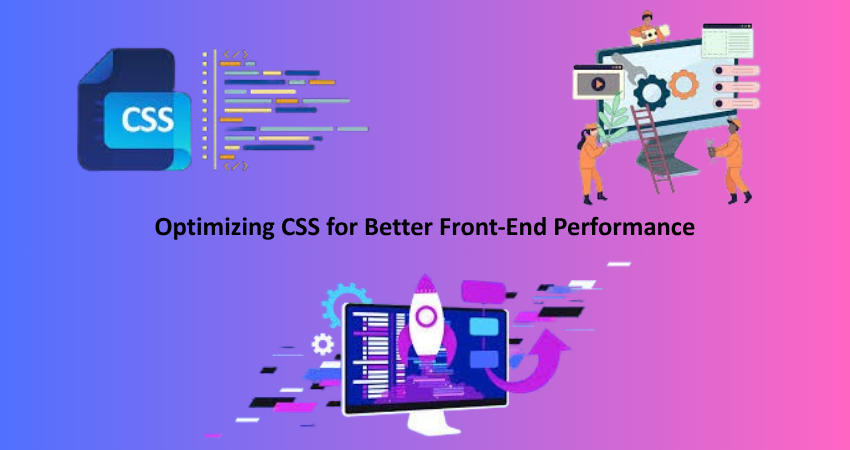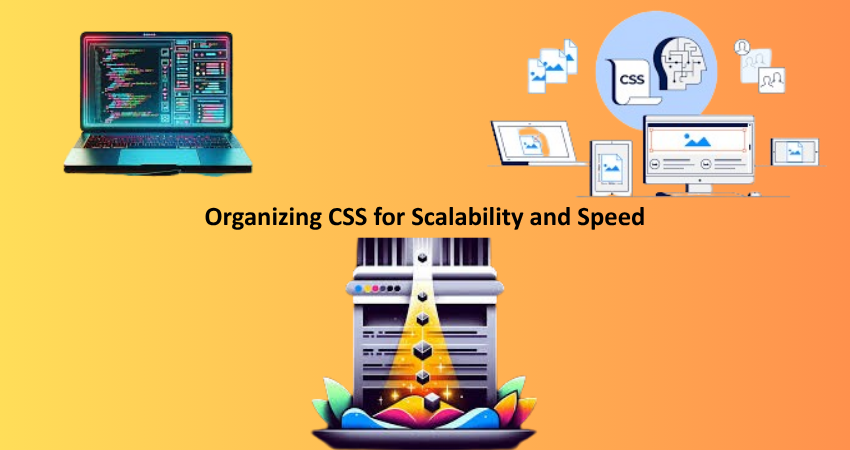
Introduction: Why CSS Optimization Matters
CSS–Cascading Style Sheets–is an important element in forming users’ perceptions and interaction with a website. When CSS is optimized, pages not only load fast but provide a good user experience, better SEO, and lesser bounce rates. When a browser requests a web page, it must download all the CSS, parse it, and apply it to the DOM before it can start presenting any content. If the CSS is heavy and unwieldy, this can tremendously hinder the rendering of the page, especially on slower connections and weaker devices. Hence, web developers must pay hefty attention to how CSS is written and structured if performance is their concern.
The ramifications of an unoptimized CSS have other consequences in addition to speed. Added complex style sheets can increase maintenance overhead, diminish code clarity, and introduce inconsistencies. As web development curves to fancier and richer graphic user interfaces, CSS has been rapidly becoming large and complex, thus the need for optimization. Developers must therefore consider using methods of minimizing without sacrificing functionalities or aesthetic appeal. If developers can know what disrupts the performance of CSS and the determinants of such, it will indeed be a way for them to ensure their sites perform in different states to allow users a close-to-an-out-of-this-world experience.
Reducing CSS File Size
Minification and Compression Techniques
Minifying and compressing CSS files sent to the client is one among the least boastful things to conduct to ramp up front-end performances. The process is called minification and simply involves the stripping of excess characters such as white space, comments, and sometimes new lines from any CSS code. While these elements improve human readability, they serve no purpose for the browser and only increase the overall file size. In other words, CSS editors like CSSNano, UglifyCSS, and CleanCSS can minimize the effort toward such tasks, so developers do not have to go through making very minute changes to their coding for the sake of efficiency. Further, these tools can often be easily integrated into build processes with the help of task runners such as Gulp and Webpack.
Compression, on the other hand, is a process done on the server level. It entails encoding the CSS file into a smaller format before sending it over the wire. Gzip and Brotli are widely-used methods for compressing and transferring files, thus reducing file transfer size without hindering functionality. In fact, the combination of both minification and compression can yield a reduction of over 70% in the final size of these CSS files, thereby rendering websites that much faster. Besides enhancing user experience, a major boost in site speed will also help in improving search engine rankings, as speed of a website is a significant factor in modern search engine optimization algorithms.
Removing Unused CSS
An equally powerful method that can help minimize a file’s size is discarding all unused CSS rules. Given that websites change during their lifetime, it is common for style sheets to acquire unused or outdated code, especially where components are removed or modified. Such leftover CSS is still loaded and parsed by the browser and adds unnecessary weight to the page. Tools like PurgeCSS, UnCSS, or frameworks like Tailwind CSS offer tree-shaking techniques that can be used to identify and remove unused styles automatically, thus rendering the file to only what is needed.
However, a great deal of caution should be exercised when it comes to cleaning out unused styles, especially if the content is generated dynamically or the styling is applied conditionally in a framework. Full testing after cleanup is essential to ensure that any styles still required have not been removed by mistake. Last but not least, integrating this cleanup into the Continuous Integration (C1) pipeline would help ensure that the style sheets remain clean and efficient over time. Regular audits of CSS files can also prove handy in this respect, especially when major updates or redesigns are undertaken, as they tend to eliminate bloat and thus keep the performance tight.
Organizing CSS for Scalability and Speed

Modular CSS and Component-Based Approaches
When CSS is modularized for building applications, it improves ways for building or managing and scaling the styles for applications. Modular CSS is dividing styles into smaller pieces that can be reused and retained easier and more clearly. It minimizes style conflicts and duplications, especially in big projects with many developers. Component-based frameworks such as BEM, SMACSS, or Atomic CSS are very effective because these frameworks provide ways of structuring methods to remodel the code into reusable artifacts, thus achieving performance.
By scoping to various components, one can eliminate most of the CSS cascade and prevent the definition of margins,’ et cetera, defined at high levels from being used. This will optimize specificity and thereby speed up the process of rendering, but it will also speed up relative time to style some styles, since it makes such styles more predictable. Component annotations improve caching, which in turn relates to re-creations that should, thus, have a positive influence on the frontend’s overall performance. Modular CSS, therefore, serves as a necessary measure towards project scalability and maintainability as an increasing number of such projects start adopting design systems and modular UI libraries.
Leveraging CSS Preprocessors
CSS preprocessors Sass, LESS, and Stylus are equipped with powerful features that enhance the manageability and efficiency of CSS. Variables, functions, and mixins reduce repetition in the code, while nesting and functions focus on code clarity and enhancements. Although they do not affect client-side performance, having code that is clean and easy to maintain encourages optimizations.
For example, declarations can be mixed for repeated use so that only the mixture has to be defined. Variables will ensure consistency within the various stylesheets being worked on. By abstracting common patterns, preprocessors give developers the opportunity to change a single place rather than repeating modifications across multiple selectors. Not only would this method save time, but it would also reduce the chances of making an error as well. When such an approach is combined with a build system that includes minification and linting, CSS preprocessors make the difference in putting together a real-world front-end workflow with the highest degree of sophistication.
Optimizing CSS Delivery
Inlining Critical CSS
This technique is known as inlining critical CSS, wherein all styles critical to display above-the-fold content are actually incorporated into the HTML document itself. Thus, the browser immediately starts rendering the page rather than waiting to download and parse external stylesheets. It can ideally bring down perceived load times, particularly on slow connections or mobile networks. Tools like Critical, PageSpeed Insights, or Penthouse can be used to find critical styles and automate the inlining process.
Nevertheless, inlining serves several critical purposes but is not without downsides. It often bloats the HTML document and makes it less maintainable. In general, inline CSS would only be that which is required for the initial rendering of the page; all other CSS can be fetched asynchronously. An adequate balance should allow a user to see a functionally active page immediately while still benefiting from being optimized for the other content being downloaded asynchronously. So that, when combined with other delivery mechanisms, such critical CSS inlining contributes a little bit more to that performance boost that catches users off guard.
Asynchronous and Deferred Loading
At this time, the performance of the front end can be enhanced with style sheets that are loaded asynchronously, hence delaying the loading of non-critical styles. CSS is blocking by default, which means that it blocks rendering of anything else until all CSS-related files are downloaded and parsed by the browser. For accomplishing this, a number of techniques have been employed, among them using media=”print” alongside onload event handlers, as well as using tools such as loadCSS for non-blocking loading of styles. This ensures faster page rendering with the critical application of styles first and the loading of non-critical styles in the background.
This is particularly important because deferred loading of styles really alters the content that slides down in front of the user. Lazy loading CSS is part of a larger umbrella that might also include lazy loading of images, Javascript, and other resources to create snappy and responsive experiences. As long as critical CSS is prioritized and inlined correctly, asynchronous loading will greatly speed the fastest way to interactivity for the user.
Enhancing Performance Through Best Practices

Avoiding Deep Nesting and High Specificity
Performance and maintainability problems stem from writing CSS with excessive nesting or specific selectors. Deeply nested rules require the rendering engine to match against more and more complicated rules; this impacts not only performance with regard to style recalc but also maintainability concerning understanding how styles render. New styles applied with high specificity might throw off existing styles, and would-if another class were called upon-be quite hard to debug: this often leads people to declare “!important,”> thus increasing specificity that would never otherwise be warranted. Thus, keeping selectors flat and simple and ensuring they are not specific will help developers not only with these scenarios but also with animating style sheets efficiently.
Following a naming convention such as BEM would produce selectors that are clear, maintainable, and performance-friendly. Shapes are not styled through worrying about deeply nested styles; rather, they pull practically everything through class selectors. With this method, the component is highly modular, and the chances of styles bleeding into unrelated elements are diminished. Nice flat CSS, then, means it will also be readable for everyone and should be readily maintainable in any big project.
Minimizing Reflows and Repaints
Displaying elemental changes that affect performance is related with the two different operation types: reflow and repaint. Reflows occur under layout CSS property modifications including width, height, and position, while other changes are associated with repaints-such as color or even visibility change displaying the changes. Style changes should be kept to a minimum, especially changes made by JavaScript; otherwise, the system will be compromised. Knowledge of heavyweight CSS properties and avoiding layout thrashing is the key to delivering smooth, responsive interfaces.
Do as little reflowing as necessary, always batch DOM changes together, and don’t call for layout properties (for example, offsetHeight) until after style changes have been made. CSS transitions and animations should be optimized to animate only properties whose changes will be treated entirely in the composite layer: those are transform and opacity, which will not invoke any layout recalculation. The Chrome DevTool can be used in the Performance tab to find the reflow/repaint that might cause issues, which would then steer developers toward more optimized styling. Keeping performance in mind throughout the development phase will eventually lead to faster and smoother websites that improve user experiences.
Conclusion: Building Fast, Efficient Stylesheets
The optimization of CSS goes beyond aesthetics; it delves into the matter of performance on the front end. Given that small and fast CSS files arrive at the server and the user’s screen after extreme shrinking via minification and cleaning up of unused styles, organized in a modular way, and smartly delivered through techniques such as critical CSS inlining, massive amount of front-end performance merits consideration. Every bit counts in optimizing a fast and efficient Web. Just like optimizing images or JavaScript files, CSS needs to be treated as a performance asset that has an optimization track built into its workflow.
Where user expectations and competition run high, performance can make or break the site. The more investment made in CSS optimization, the more returns will be buried from quicker load times and better SEO, increased accessibility, and subsequently increased user retention. From a small personal blog to a gigantic application, mastering CSS performance techniques ensures that a site becomes equally eye-catching and technically sound.